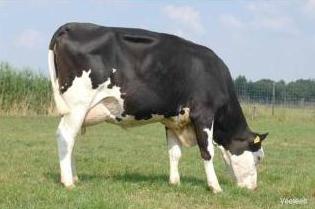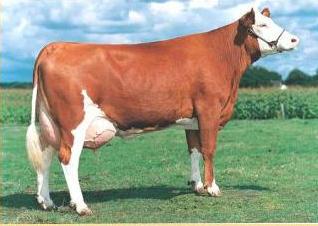New breed of dairy cattle
A new breed of dairy cattle was launched in June 2010. The breed is a cross between the Friesian and Fleckvieh from Germany. It was introduced by a German firm, Fleckvieh Ltd and has benefited about 500 farmers in Kiambu County. It is said the breed has many advantages which include
- high milk production
- very prolific - can give one calf every year for eight years
- minimal veterinary demands
The Fleckvieh breed of cattle is said to be a high yielding, dual-purpose cow developed for both dairy and beef production. Also referred to as Miling Simmental because of its origin from the Simmental breed of cattle, the breed was developed in Germany and introduced into Kenya from South Africa in 2009. It is marketed in Kenya and East Africa by Fleckvieh Genetics East Africa (FGEA). Since its introduction the breed has been adopted by more than 20,000 farmers in Kiambu, Malindi and other parts of the country.
Breed Characteristics and Performance
- The color can be either black and white or red and white.

- They are docile and easy to manage.
- The breed is hardy and adapts well to difficult environmental conditions.
- A mature cow weighs between 650-800 kilograms.
- Having lower numbers of somatic cells in the milk compared to other dairy breeds the breed is resistant to mastitis and the milk lasts longer without refrigeration. Fleckvieh milk last 24 hours before spoiling compared to 7 to 10 hours for other dairy breeds.
- Ticks and tsetse flies cannot easily penetrate their very thick and tough skin and this makes them resistant to tick-borne and tsetse transmitted diseases.
- At 4.2% the Fleckvieh milk butterfat content is higher than that of either the Ayrshire or Friesian breeds.
- Fleckvieh have a faster growth rate than other beef and dairy breeds. If fed properly a calf can weigh 300kgs in six months.
- The feed conversion rate is higher compared to other dairy cattle. The Friesian breed consumes an average of 70kgs daily whereas the Fleckvieh consumes only 40kg to produce the same amount of milk or meat. But on the flip side though the Fleckvieh is able to sustain its larger body mass on less feed, it produces less dung than for other breeds and therefore less manure for the dairy farmer.
- Compared to the 7800 kg per lactation of Friesian breeds, the Fleckvieh produces an average of 7500 kg during the first lactation and reaches up to 10,000 kg in the third lactation.
A Fleckvieh heifer goes for about Kshs 250,000 making it unaffordable to majority of dairy and beef farmers in Kenya. The cheapest way to get this breed is through artificial insemination of livestock where farmers can cross with their dairy or beef cows. In this process over 75% of the Fleckvieh genetics is passed to the offspring whereas the general standard for this transfer is 50 per cent. This is a very high rate of genetic gain and dairy farmers can quickly improve their herds in a very short time. Farmers are encouraged to get semen from these top bulls available at a price ranging from Kshs 400 to 800.
beef farmers in Kenya. The cheapest way to get this breed is through artificial insemination of livestock where farmers can cross with their dairy or beef cows. In this process over 75% of the Fleckvieh genetics is passed to the offspring whereas the general standard for this transfer is 50 per cent. This is a very high rate of genetic gain and dairy farmers can quickly improve their herds in a very short time. Farmers are encouraged to get semen from these top bulls available at a price ranging from Kshs 400 to 800.
Therefore with faster maturity and higher milk production the Fleckvieh breed is an addition to the important dairy breeds of cattle in Kenya. Interested farmers can contact Fleckvieh at their website Fleckvieh Genetics (EA) Ltd or call Mobile 0721 095 555, 0734 095 555, 0725 665 885, 0733095555 or 0712095555.



